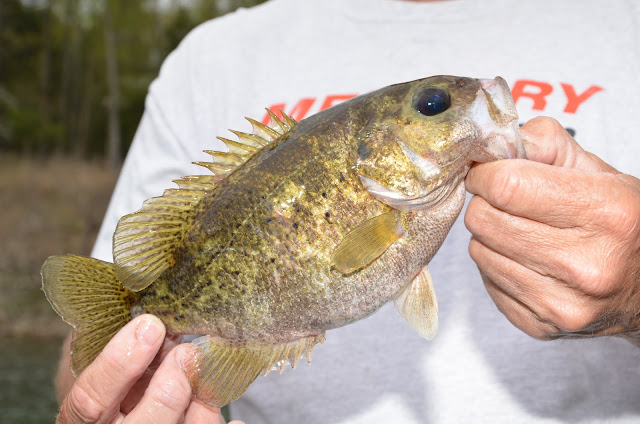Rock Bass or commonly known as Goggle-eye
Rock bass are to Ozark flowing streams what crappie are to reservoirs. Creel census figures show that they make up the largest percentage of fish caught and fish kept by stream fishermen in the Ozarks. Missouri fisheries people once kept track of the fish coming out of the Big Piney, Current, Niangua, Huzzah, and Courtois, and they figured goggle-eye made up 25 to 35 percent of the fish caught and kept. It is likely they overlooked the green sunfish caught when they did that survey. Green Sunfish most likely are caught at a very high rate, but not often kept. Biologists from that long-ago time also did a study of growth rates, which showed that rock bass on the Black and Jacks Fork Rivers were three years old when they reach six inches in length. But at Bennett Springs, next to the Niangua River, they were six inches long at two years. Three-year-old goggle-eye there were about eight inches long. Eleven-inch fish (a real rarity even then) from the same waters were seven years old.
Rock bass will quite commonly reach a weight of one-half to three-fourths of a pound in the Ozarks. And goggle-eye of one-and-a- half pounds can be seen on occasion. A heavier fish in the Ozarks is a true lunker, in the same realm as a five-pound smallmouth or a ten-pound largemouth
I know of a two-pound rock bass taken from the Big Piney River right at the mouth of Hog Creek back in the early ‘60s. My Uncle was fishing just after dark in a deep hole with a jitterbug, trying to catch a big smallmouth. That huge rock bass, which he landed, was the only one I ever knew to hit a jitterbug at night.
That’s one thing that really stands out to me in the years of river fishing I’ve done. If you want to catch rock bass, fish the bottom, use small lures, and fish slow. Despite the things I’ve read about rock bass hitting flies cast by fly-fishermen, I’ve seldom seen them come up after anything on top.
When I was a boy and Dad and I floated the Big Piney and Little Piney Rivers in April, we had the best lure I’ve ever seen for goggle-eye. A man named Art Varner from Salem, Missouri, made a small spinnerbait called a shimmy fly. These lures, one-eight and one-fourth ounce had lead heads and honeybee yellow and black or yellow and brown bodies, with brown or black squirrel hair tied over them. The small offset spinner rode just above the body, and we’d dress this up with a split white pork rind fly strip.
When shimmy flies became hard to find, beetle spins began to appear, and now there are a variety of plastic lures on the same type of spinners, which are very effective for rock bass.
The colors don’t make a great deal of difference.
Of course, natural-bait fishermen will tell you nothing will beat a night crawler, and that is indeed a favorite of rock bass in the summer.
In the spring, they may spawn just below a swift shoal in water as shallow as three feet. In April and May, there’s no problem catching them during the day. In fact, when they are preparing to spawn in the spring, you may catch a dozen or so rock bass in one spot, any time of the day. In June they begin to spread out, seek deeper water, and feed well at night going to the deepest water and coming out at dusk. If you like to fish with night crawlers after dark in a deep river eddy, you will find that they are a bit nocturnal then.
The rock bass does indeed love rocks, but some of the best fishing I’ve had with minnows and night crawlers has been around large root wads of fallen trees washed into deep water any time of the year, any time of the day. They love a big submerged root wad just as much as a big rock.
Something else I’ve noticed about rock bass in the Ozarks, is that they seem to go on feeding binges when a heavy rain muddies the stream and creates a small rise. Sometimes during a rise they move into areas of sand or gravel substrate where they normally wouldn’t be found. Years ago, when there was a slow rise in the river, and murky water coming with it, I would go to some favorite spots and catch lots of rock bass on nightcrawlers, along with bass, green sunfish, and suckers.
I seldom fish for them today, as upper reaches of Ozarks streams have become shallow, and the rocks I once fished are becoming covered with silt and gravel. Progress…land clearing and erosion! But last spring I made a trip on the lower Big Piney with old-time riverman and fishing guide, Charlie Curran, and we found lots of goggle-eye to be caught on small rubber grubs fished slowly close to the bottom in deeper water. But 80 percent were less than 8 inches. In most streams where rocks are found in deeper water not yet filled ion. Ozark goggle-eye can thrive, IF fishermen will abide by that 8-inch rule. They have gone through hard times, but anglers willing to return all smallmouth, and return any rock bass under 8 inches, can play a big role in keeping rivers something like they were in that time long ago when only wooden johnboats drifted downstream, in the land of brownies, black perch and goggle-eyes!


No comments:
Post a Comment